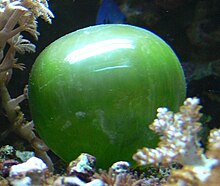Single celled organism
| Unicellular organism | |
|---|---|

Valonia ventricosa, a species of alga with a diameter that ranges typically from 1 to 4 centimetres (0.39 to 1.57 in) is among the largest unicellular species
|
A unicellular organism, also known as a single-celled organism, is an organism that consists of only one cell, unlike a multicellular organism that consists of more than one cell. Historically, simple unicellular organisms have been referred to as monads, though this term is also used more specifically to describe organisms of the genus Monas and similar flagellate ameboids. The main groups of unicellular organisms are bacteria, archaea, protozoa, unicellular algae, and unicellular fungi. Unicellular organisms fall into two general categories: prokaryotic organisms and eukaryotic organisms. Unicellular organisms are thought to be the oldest form of life, with early possibly emerging 3.8–4 billion years ago.
Prokaryotes, most Protista, and some fungi are unicellular. Although some of these organisms live in colonies, they don't exhibit specialization. These organisms live together, and each cell in the colony is the same. However, each individual cell must carry out all life processes to survive. In contrast, even the simplest multicellular organisms have cells that depend on each other to survive.
Most multicellular organisms have a unicellular life-cycle stage. Gametes, for example, are reproductive unicells for multicellular organisms. Additionally, multicellularity appears to have evolved independently many times in the history of life.
Some organisms are partially uni- and multicellular, like Dictyostelium discoideum. Additionally, unicellular organisms can be multinucleate, like Myxogastria and Plasmodium.
...
Wikipedia
